Business Law Report: Case Studies on Contract and Tort Law
VerifiedAdded on 2022/12/30
|7
|2397
|20
Report
AI Summary
This report provides a detailed analysis of business law, focusing on contract and tort law principles. Part A examines a case involving a minor's capacity to contract, exploring the validity of an agreement between a mother and her daughter, highlighting issues of voidable contracts and breach of contract. Part B delves into a case study on negligence, evaluating the liability of a local authority for a spinal injury sustained at Bondi Beach, and discussing contributory negligence. The report analyzes the legal rules, applications, and court decisions related to these cases, concluding with the outcomes and implications for both parties involved. The report is a comprehensive resource for students studying business law, providing insights into key concepts such as contractual capacity, breach of contract, negligence, and contributory negligence.
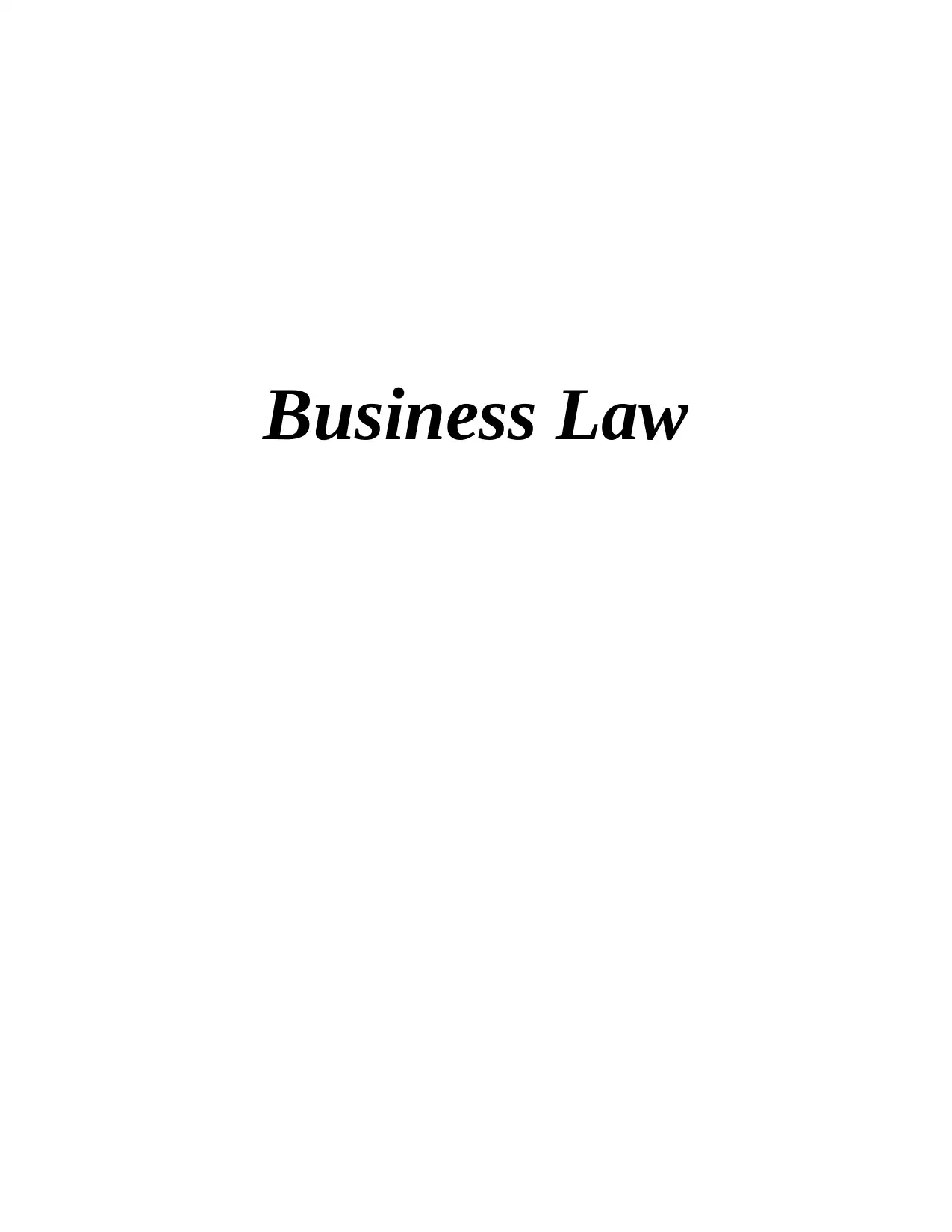
Business Law
Paraphrase This Document
Need a fresh take? Get an instant paraphrase of this document with our AI Paraphraser
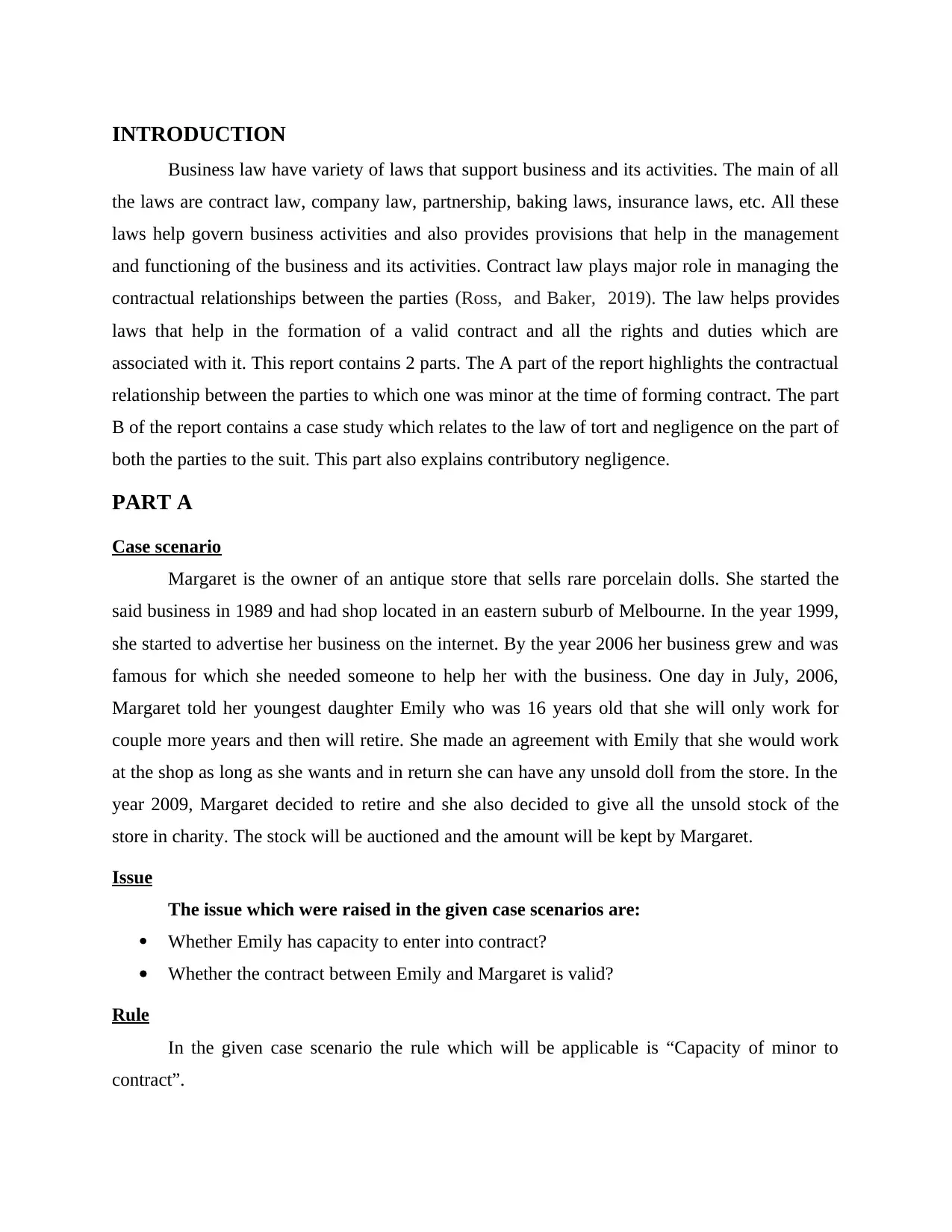
INTRODUCTION
Business law have variety of laws that support business and its activities. The main of all
the laws are contract law, company law, partnership, baking laws, insurance laws, etc. All these
laws help govern business activities and also provides provisions that help in the management
and functioning of the business and its activities. Contract law plays major role in managing the
contractual relationships between the parties (Ross, and Baker, 2019). The law helps provides
laws that help in the formation of a valid contract and all the rights and duties which are
associated with it. This report contains 2 parts. The A part of the report highlights the contractual
relationship between the parties to which one was minor at the time of forming contract. The part
B of the report contains a case study which relates to the law of tort and negligence on the part of
both the parties to the suit. This part also explains contributory negligence.
PART A
Case scenario
Margaret is the owner of an antique store that sells rare porcelain dolls. She started the
said business in 1989 and had shop located in an eastern suburb of Melbourne. In the year 1999,
she started to advertise her business on the internet. By the year 2006 her business grew and was
famous for which she needed someone to help her with the business. One day in July, 2006,
Margaret told her youngest daughter Emily who was 16 years old that she will only work for
couple more years and then will retire. She made an agreement with Emily that she would work
at the shop as long as she wants and in return she can have any unsold doll from the store. In the
year 2009, Margaret decided to retire and she also decided to give all the unsold stock of the
store in charity. The stock will be auctioned and the amount will be kept by Margaret.
Issue
The issue which were raised in the given case scenarios are:
Whether Emily has capacity to enter into contract?
Whether the contract between Emily and Margaret is valid?
Rule
In the given case scenario the rule which will be applicable is “Capacity of minor to
contract”.
Business law have variety of laws that support business and its activities. The main of all
the laws are contract law, company law, partnership, baking laws, insurance laws, etc. All these
laws help govern business activities and also provides provisions that help in the management
and functioning of the business and its activities. Contract law plays major role in managing the
contractual relationships between the parties (Ross, and Baker, 2019). The law helps provides
laws that help in the formation of a valid contract and all the rights and duties which are
associated with it. This report contains 2 parts. The A part of the report highlights the contractual
relationship between the parties to which one was minor at the time of forming contract. The part
B of the report contains a case study which relates to the law of tort and negligence on the part of
both the parties to the suit. This part also explains contributory negligence.
PART A
Case scenario
Margaret is the owner of an antique store that sells rare porcelain dolls. She started the
said business in 1989 and had shop located in an eastern suburb of Melbourne. In the year 1999,
she started to advertise her business on the internet. By the year 2006 her business grew and was
famous for which she needed someone to help her with the business. One day in July, 2006,
Margaret told her youngest daughter Emily who was 16 years old that she will only work for
couple more years and then will retire. She made an agreement with Emily that she would work
at the shop as long as she wants and in return she can have any unsold doll from the store. In the
year 2009, Margaret decided to retire and she also decided to give all the unsold stock of the
store in charity. The stock will be auctioned and the amount will be kept by Margaret.
Issue
The issue which were raised in the given case scenarios are:
Whether Emily has capacity to enter into contract?
Whether the contract between Emily and Margaret is valid?
Rule
In the given case scenario the rule which will be applicable is “Capacity of minor to
contract”.
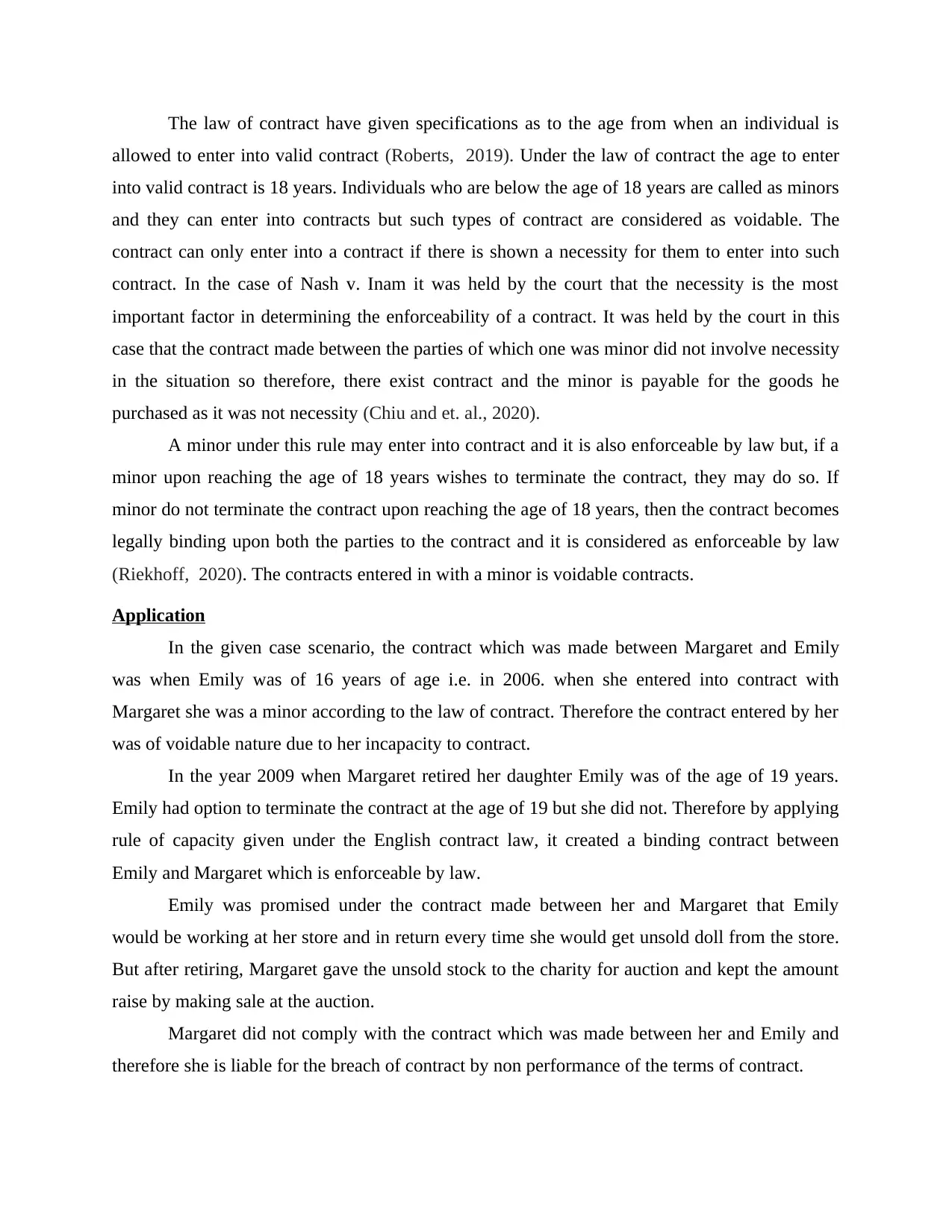
The law of contract have given specifications as to the age from when an individual is
allowed to enter into valid contract (Roberts, 2019). Under the law of contract the age to enter
into valid contract is 18 years. Individuals who are below the age of 18 years are called as minors
and they can enter into contracts but such types of contract are considered as voidable. The
contract can only enter into a contract if there is shown a necessity for them to enter into such
contract. In the case of Nash v. Inam it was held by the court that the necessity is the most
important factor in determining the enforceability of a contract. It was held by the court in this
case that the contract made between the parties of which one was minor did not involve necessity
in the situation so therefore, there exist contract and the minor is payable for the goods he
purchased as it was not necessity (Chiu and et. al., 2020).
A minor under this rule may enter into contract and it is also enforceable by law but, if a
minor upon reaching the age of 18 years wishes to terminate the contract, they may do so. If
minor do not terminate the contract upon reaching the age of 18 years, then the contract becomes
legally binding upon both the parties to the contract and it is considered as enforceable by law
(Riekhoff, 2020). The contracts entered in with a minor is voidable contracts.
Application
In the given case scenario, the contract which was made between Margaret and Emily
was when Emily was of 16 years of age i.e. in 2006. when she entered into contract with
Margaret she was a minor according to the law of contract. Therefore the contract entered by her
was of voidable nature due to her incapacity to contract.
In the year 2009 when Margaret retired her daughter Emily was of the age of 19 years.
Emily had option to terminate the contract at the age of 19 but she did not. Therefore by applying
rule of capacity given under the English contract law, it created a binding contract between
Emily and Margaret which is enforceable by law.
Emily was promised under the contract made between her and Margaret that Emily
would be working at her store and in return every time she would get unsold doll from the store.
But after retiring, Margaret gave the unsold stock to the charity for auction and kept the amount
raise by making sale at the auction.
Margaret did not comply with the contract which was made between her and Emily and
therefore she is liable for the breach of contract by non performance of the terms of contract.
allowed to enter into valid contract (Roberts, 2019). Under the law of contract the age to enter
into valid contract is 18 years. Individuals who are below the age of 18 years are called as minors
and they can enter into contracts but such types of contract are considered as voidable. The
contract can only enter into a contract if there is shown a necessity for them to enter into such
contract. In the case of Nash v. Inam it was held by the court that the necessity is the most
important factor in determining the enforceability of a contract. It was held by the court in this
case that the contract made between the parties of which one was minor did not involve necessity
in the situation so therefore, there exist contract and the minor is payable for the goods he
purchased as it was not necessity (Chiu and et. al., 2020).
A minor under this rule may enter into contract and it is also enforceable by law but, if a
minor upon reaching the age of 18 years wishes to terminate the contract, they may do so. If
minor do not terminate the contract upon reaching the age of 18 years, then the contract becomes
legally binding upon both the parties to the contract and it is considered as enforceable by law
(Riekhoff, 2020). The contracts entered in with a minor is voidable contracts.
Application
In the given case scenario, the contract which was made between Margaret and Emily
was when Emily was of 16 years of age i.e. in 2006. when she entered into contract with
Margaret she was a minor according to the law of contract. Therefore the contract entered by her
was of voidable nature due to her incapacity to contract.
In the year 2009 when Margaret retired her daughter Emily was of the age of 19 years.
Emily had option to terminate the contract at the age of 19 but she did not. Therefore by applying
rule of capacity given under the English contract law, it created a binding contract between
Emily and Margaret which is enforceable by law.
Emily was promised under the contract made between her and Margaret that Emily
would be working at her store and in return every time she would get unsold doll from the store.
But after retiring, Margaret gave the unsold stock to the charity for auction and kept the amount
raise by making sale at the auction.
Margaret did not comply with the contract which was made between her and Emily and
therefore she is liable for the breach of contract by non performance of the terms of contract.
⊘ This is a preview!⊘
Do you want full access?
Subscribe today to unlock all pages.

Trusted by 1+ million students worldwide
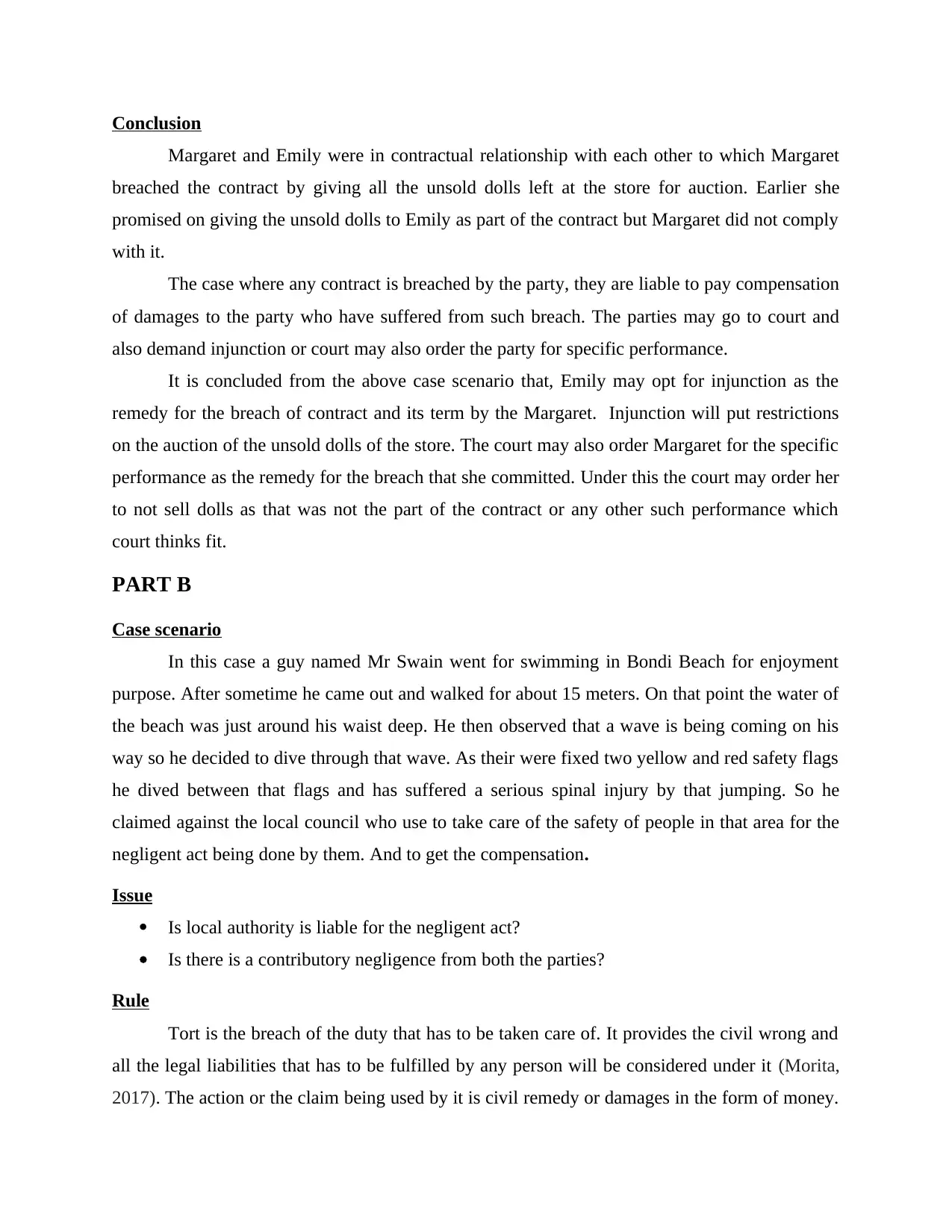
Conclusion
Margaret and Emily were in contractual relationship with each other to which Margaret
breached the contract by giving all the unsold dolls left at the store for auction. Earlier she
promised on giving the unsold dolls to Emily as part of the contract but Margaret did not comply
with it.
The case where any contract is breached by the party, they are liable to pay compensation
of damages to the party who have suffered from such breach. The parties may go to court and
also demand injunction or court may also order the party for specific performance.
It is concluded from the above case scenario that, Emily may opt for injunction as the
remedy for the breach of contract and its term by the Margaret. Injunction will put restrictions
on the auction of the unsold dolls of the store. The court may also order Margaret for the specific
performance as the remedy for the breach that she committed. Under this the court may order her
to not sell dolls as that was not the part of the contract or any other such performance which
court thinks fit.
PART B
Case scenario
In this case a guy named Mr Swain went for swimming in Bondi Beach for enjoyment
purpose. After sometime he came out and walked for about 15 meters. On that point the water of
the beach was just around his waist deep. He then observed that a wave is being coming on his
way so he decided to dive through that wave. As their were fixed two yellow and red safety flags
he dived between that flags and has suffered a serious spinal injury by that jumping. So he
claimed against the local council who use to take care of the safety of people in that area for the
negligent act being done by them. And to get the compensation.
Issue
Is local authority is liable for the negligent act?
Is there is a contributory negligence from both the parties?
Rule
Tort is the breach of the duty that has to be taken care of. It provides the civil wrong and
all the legal liabilities that has to be fulfilled by any person will be considered under it (Morita,
2017). The action or the claim being used by it is civil remedy or damages in the form of money.
Margaret and Emily were in contractual relationship with each other to which Margaret
breached the contract by giving all the unsold dolls left at the store for auction. Earlier she
promised on giving the unsold dolls to Emily as part of the contract but Margaret did not comply
with it.
The case where any contract is breached by the party, they are liable to pay compensation
of damages to the party who have suffered from such breach. The parties may go to court and
also demand injunction or court may also order the party for specific performance.
It is concluded from the above case scenario that, Emily may opt for injunction as the
remedy for the breach of contract and its term by the Margaret. Injunction will put restrictions
on the auction of the unsold dolls of the store. The court may also order Margaret for the specific
performance as the remedy for the breach that she committed. Under this the court may order her
to not sell dolls as that was not the part of the contract or any other such performance which
court thinks fit.
PART B
Case scenario
In this case a guy named Mr Swain went for swimming in Bondi Beach for enjoyment
purpose. After sometime he came out and walked for about 15 meters. On that point the water of
the beach was just around his waist deep. He then observed that a wave is being coming on his
way so he decided to dive through that wave. As their were fixed two yellow and red safety flags
he dived between that flags and has suffered a serious spinal injury by that jumping. So he
claimed against the local council who use to take care of the safety of people in that area for the
negligent act being done by them. And to get the compensation.
Issue
Is local authority is liable for the negligent act?
Is there is a contributory negligence from both the parties?
Rule
Tort is the breach of the duty that has to be taken care of. It provides the civil wrong and
all the legal liabilities that has to be fulfilled by any person will be considered under it (Morita,
2017). The action or the claim being used by it is civil remedy or damages in the form of money.
Paraphrase This Document
Need a fresh take? Get an instant paraphrase of this document with our AI Paraphraser
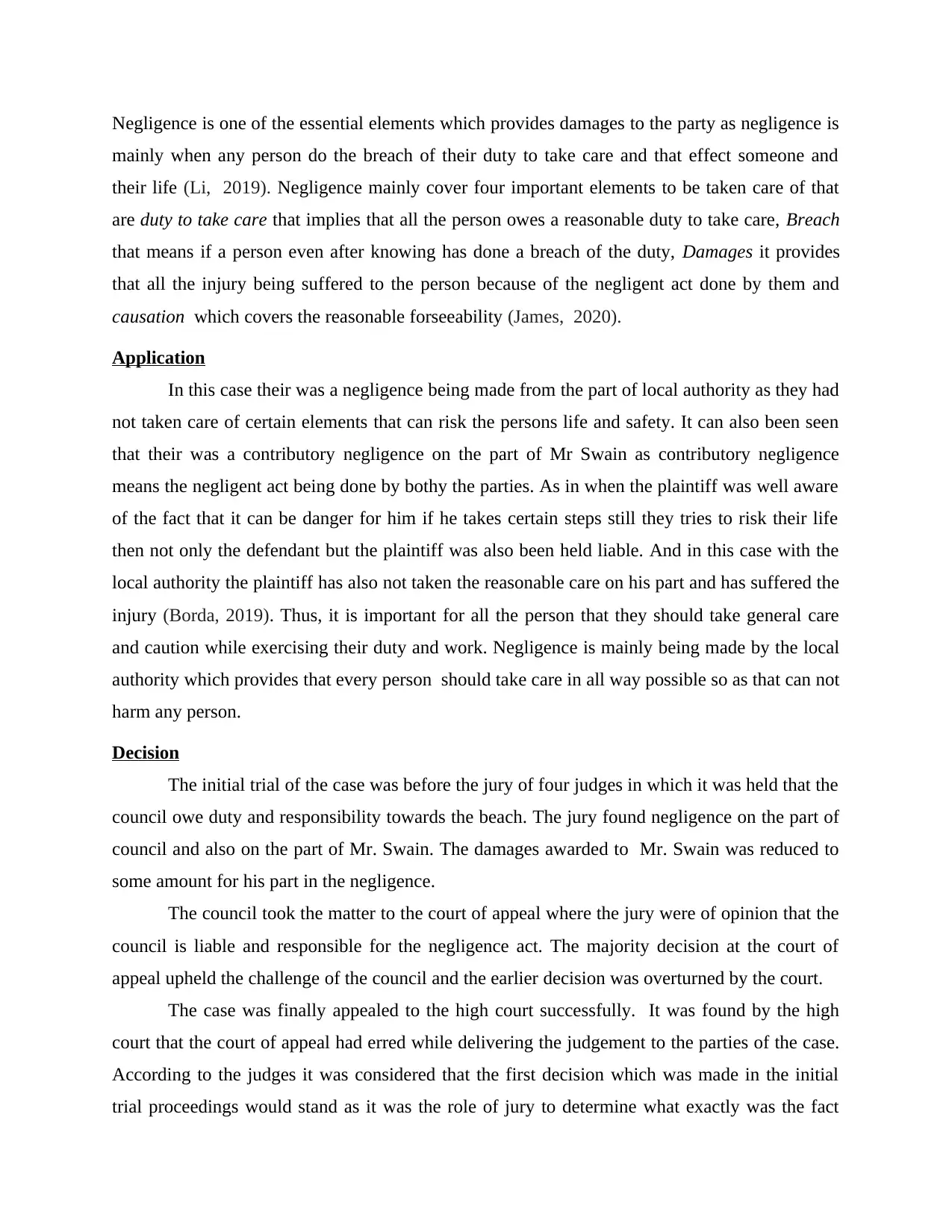
Negligence is one of the essential elements which provides damages to the party as negligence is
mainly when any person do the breach of their duty to take care and that effect someone and
their life (Li, 2019). Negligence mainly cover four important elements to be taken care of that
are duty to take care that implies that all the person owes a reasonable duty to take care, Breach
that means if a person even after knowing has done a breach of the duty, Damages it provides
that all the injury being suffered to the person because of the negligent act done by them and
causation which covers the reasonable forseeability (James, 2020).
Application
In this case their was a negligence being made from the part of local authority as they had
not taken care of certain elements that can risk the persons life and safety. It can also been seen
that their was a contributory negligence on the part of Mr Swain as contributory negligence
means the negligent act being done by bothy the parties. As in when the plaintiff was well aware
of the fact that it can be danger for him if he takes certain steps still they tries to risk their life
then not only the defendant but the plaintiff was also been held liable. And in this case with the
local authority the plaintiff has also not taken the reasonable care on his part and has suffered the
injury (Borda, 2019). Thus, it is important for all the person that they should take general care
and caution while exercising their duty and work. Negligence is mainly being made by the local
authority which provides that every person should take care in all way possible so as that can not
harm any person.
Decision
The initial trial of the case was before the jury of four judges in which it was held that the
council owe duty and responsibility towards the beach. The jury found negligence on the part of
council and also on the part of Mr. Swain. The damages awarded to Mr. Swain was reduced to
some amount for his part in the negligence.
The council took the matter to the court of appeal where the jury were of opinion that the
council is liable and responsible for the negligence act. The majority decision at the court of
appeal upheld the challenge of the council and the earlier decision was overturned by the court.
The case was finally appealed to the high court successfully. It was found by the high
court that the court of appeal had erred while delivering the judgement to the parties of the case.
According to the judges it was considered that the first decision which was made in the initial
trial proceedings would stand as it was the role of jury to determine what exactly was the fact
mainly when any person do the breach of their duty to take care and that effect someone and
their life (Li, 2019). Negligence mainly cover four important elements to be taken care of that
are duty to take care that implies that all the person owes a reasonable duty to take care, Breach
that means if a person even after knowing has done a breach of the duty, Damages it provides
that all the injury being suffered to the person because of the negligent act done by them and
causation which covers the reasonable forseeability (James, 2020).
Application
In this case their was a negligence being made from the part of local authority as they had
not taken care of certain elements that can risk the persons life and safety. It can also been seen
that their was a contributory negligence on the part of Mr Swain as contributory negligence
means the negligent act being done by bothy the parties. As in when the plaintiff was well aware
of the fact that it can be danger for him if he takes certain steps still they tries to risk their life
then not only the defendant but the plaintiff was also been held liable. And in this case with the
local authority the plaintiff has also not taken the reasonable care on his part and has suffered the
injury (Borda, 2019). Thus, it is important for all the person that they should take general care
and caution while exercising their duty and work. Negligence is mainly being made by the local
authority which provides that every person should take care in all way possible so as that can not
harm any person.
Decision
The initial trial of the case was before the jury of four judges in which it was held that the
council owe duty and responsibility towards the beach. The jury found negligence on the part of
council and also on the part of Mr. Swain. The damages awarded to Mr. Swain was reduced to
some amount for his part in the negligence.
The council took the matter to the court of appeal where the jury were of opinion that the
council is liable and responsible for the negligence act. The majority decision at the court of
appeal upheld the challenge of the council and the earlier decision was overturned by the court.
The case was finally appealed to the high court successfully. It was found by the high
court that the court of appeal had erred while delivering the judgement to the parties of the case.
According to the judges it was considered that the first decision which was made in the initial
trial proceedings would stand as it was the role of jury to determine what exactly was the fact
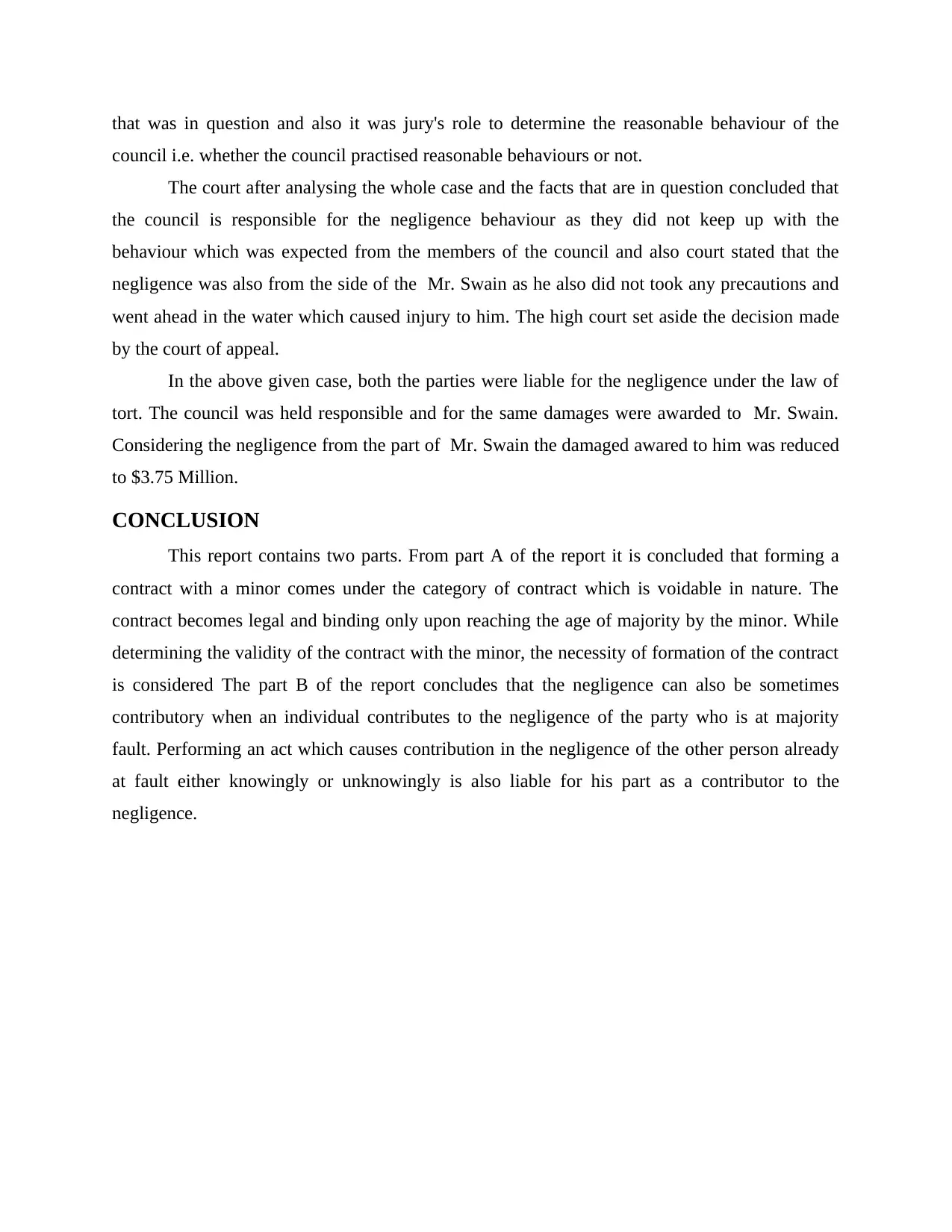
that was in question and also it was jury's role to determine the reasonable behaviour of the
council i.e. whether the council practised reasonable behaviours or not.
The court after analysing the whole case and the facts that are in question concluded that
the council is responsible for the negligence behaviour as they did not keep up with the
behaviour which was expected from the members of the council and also court stated that the
negligence was also from the side of the Mr. Swain as he also did not took any precautions and
went ahead in the water which caused injury to him. The high court set aside the decision made
by the court of appeal.
In the above given case, both the parties were liable for the negligence under the law of
tort. The council was held responsible and for the same damages were awarded to Mr. Swain.
Considering the negligence from the part of Mr. Swain the damaged awared to him was reduced
to $3.75 Million.
CONCLUSION
This report contains two parts. From part A of the report it is concluded that forming a
contract with a minor comes under the category of contract which is voidable in nature. The
contract becomes legal and binding only upon reaching the age of majority by the minor. While
determining the validity of the contract with the minor, the necessity of formation of the contract
is considered The part B of the report concludes that the negligence can also be sometimes
contributory when an individual contributes to the negligence of the party who is at majority
fault. Performing an act which causes contribution in the negligence of the other person already
at fault either knowingly or unknowingly is also liable for his part as a contributor to the
negligence.
council i.e. whether the council practised reasonable behaviours or not.
The court after analysing the whole case and the facts that are in question concluded that
the council is responsible for the negligence behaviour as they did not keep up with the
behaviour which was expected from the members of the council and also court stated that the
negligence was also from the side of the Mr. Swain as he also did not took any precautions and
went ahead in the water which caused injury to him. The high court set aside the decision made
by the court of appeal.
In the above given case, both the parties were liable for the negligence under the law of
tort. The council was held responsible and for the same damages were awarded to Mr. Swain.
Considering the negligence from the part of Mr. Swain the damaged awared to him was reduced
to $3.75 Million.
CONCLUSION
This report contains two parts. From part A of the report it is concluded that forming a
contract with a minor comes under the category of contract which is voidable in nature. The
contract becomes legal and binding only upon reaching the age of majority by the minor. While
determining the validity of the contract with the minor, the necessity of formation of the contract
is considered The part B of the report concludes that the negligence can also be sometimes
contributory when an individual contributes to the negligence of the party who is at majority
fault. Performing an act which causes contribution in the negligence of the other person already
at fault either knowingly or unknowingly is also liable for his part as a contributor to the
negligence.
⊘ This is a preview!⊘
Do you want full access?
Subscribe today to unlock all pages.

Trusted by 1+ million students worldwide
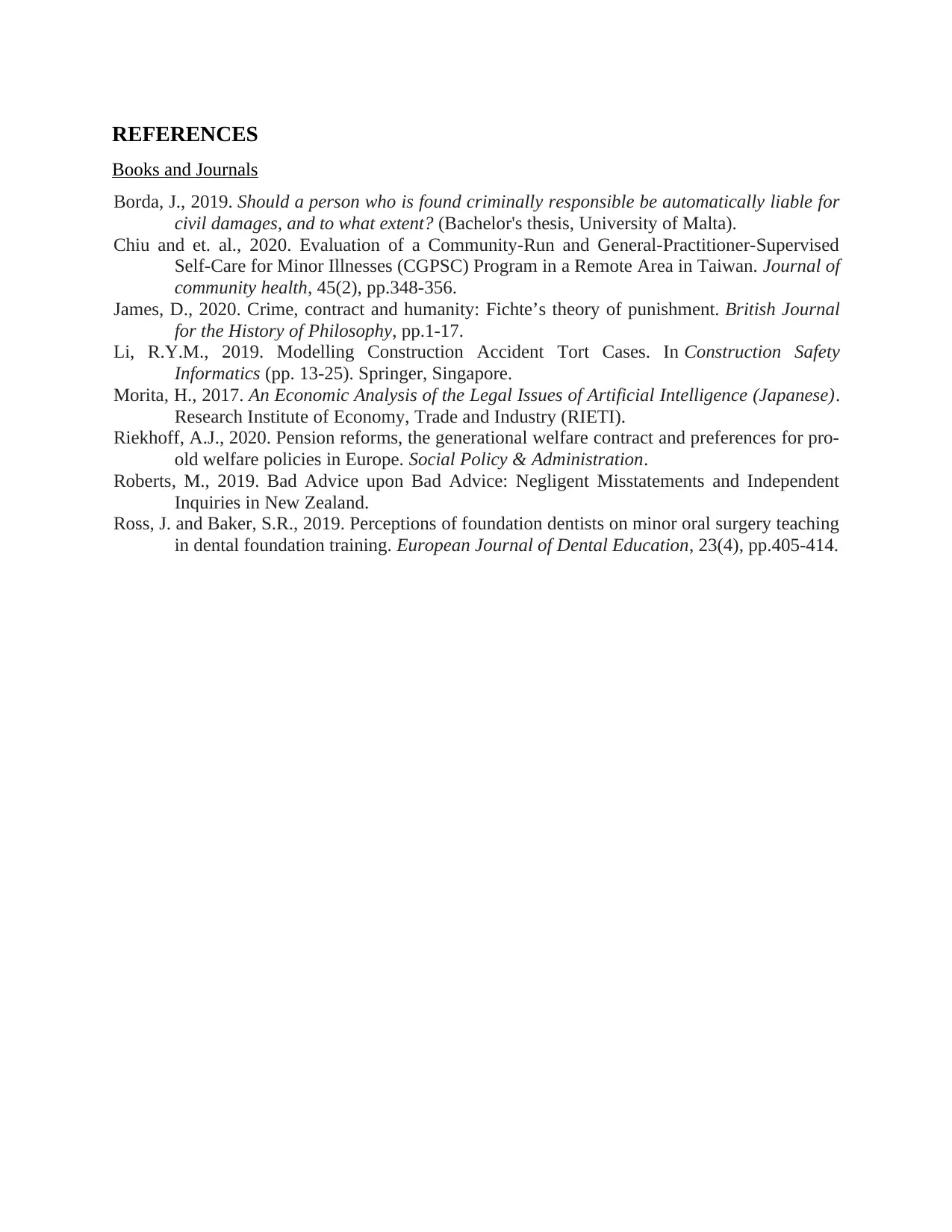
REFERENCES
Books and Journals
Borda, J., 2019. Should a person who is found criminally responsible be automatically liable for
civil damages, and to what extent? (Bachelor's thesis, University of Malta).
Chiu and et. al., 2020. Evaluation of a Community-Run and General-Practitioner-Supervised
Self-Care for Minor Illnesses (CGPSC) Program in a Remote Area in Taiwan. Journal of
community health, 45(2), pp.348-356.
James, D., 2020. Crime, contract and humanity: Fichte’s theory of punishment. British Journal
for the History of Philosophy, pp.1-17.
Li, R.Y.M., 2019. Modelling Construction Accident Tort Cases. In Construction Safety
Informatics (pp. 13-25). Springer, Singapore.
Morita, H., 2017. An Economic Analysis of the Legal Issues of Artificial Intelligence (Japanese).
Research Institute of Economy, Trade and Industry (RIETI).
Riekhoff, A.J., 2020. Pension reforms, the generational welfare contract and preferences for pro‐
old welfare policies in Europe. Social Policy & Administration.
Roberts, M., 2019. Bad Advice upon Bad Advice: Negligent Misstatements and Independent
Inquiries in New Zealand.
Ross, J. and Baker, S.R., 2019. Perceptions of foundation dentists on minor oral surgery teaching
in dental foundation training. European Journal of Dental Education, 23(4), pp.405-414.
Books and Journals
Borda, J., 2019. Should a person who is found criminally responsible be automatically liable for
civil damages, and to what extent? (Bachelor's thesis, University of Malta).
Chiu and et. al., 2020. Evaluation of a Community-Run and General-Practitioner-Supervised
Self-Care for Minor Illnesses (CGPSC) Program in a Remote Area in Taiwan. Journal of
community health, 45(2), pp.348-356.
James, D., 2020. Crime, contract and humanity: Fichte’s theory of punishment. British Journal
for the History of Philosophy, pp.1-17.
Li, R.Y.M., 2019. Modelling Construction Accident Tort Cases. In Construction Safety
Informatics (pp. 13-25). Springer, Singapore.
Morita, H., 2017. An Economic Analysis of the Legal Issues of Artificial Intelligence (Japanese).
Research Institute of Economy, Trade and Industry (RIETI).
Riekhoff, A.J., 2020. Pension reforms, the generational welfare contract and preferences for pro‐
old welfare policies in Europe. Social Policy & Administration.
Roberts, M., 2019. Bad Advice upon Bad Advice: Negligent Misstatements and Independent
Inquiries in New Zealand.
Ross, J. and Baker, S.R., 2019. Perceptions of foundation dentists on minor oral surgery teaching
in dental foundation training. European Journal of Dental Education, 23(4), pp.405-414.
1 out of 7
Related Documents
Your All-in-One AI-Powered Toolkit for Academic Success.
+13062052269
info@desklib.com
Available 24*7 on WhatsApp / Email
![[object Object]](/_next/static/media/star-bottom.7253800d.svg)
Unlock your academic potential
Copyright © 2020–2025 A2Z Services. All Rights Reserved. Developed and managed by ZUCOL.





